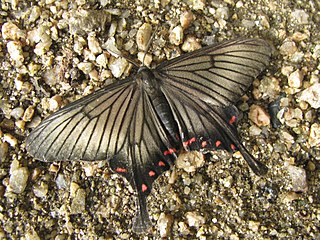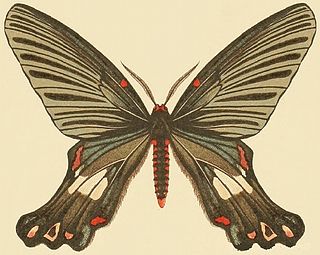
Heliothis is a genus of moths in the family Noctuidae. It was first described by Ferdinand Ochsenheimer in 1816. Some of the species have larvae which are agricultural pests on crop species such as tobacco, cotton, soybean and pigeon pea. Some species originally in this genus have been moved to other genera, see Chloridea and Helicoverpa.
Mencía is a feminine given name of Spanish origin, as well as a surname. It may refer to:
Calymniops is a monotypic moth genus of the family Erebidae erected by George Hampson in 1926. Its only species, Calymniops trapezata, was first described by Frederic Moore in 1887. It is found in India, Sri Lanka, Japan and parts of North America.

Episteme is a genus of moths of the family Noctuidae. The genus was erected by Jacob Hübner in 1820. Species are widespread.

Mimeusemia is a genus of moths of the family Noctuidae first described by Arthur Gardiner Butler in 1875. Species are found in Japan, India, Sri Lanka and Myanmar.

Niphonyx is a monotypic moth genus of the family Noctuidae erected by Shigero Sugi in 1982. Its only species, Niphonyx segregata, the hops angleshade, was first described by Arthur Gardiner Butler in 1878. It is endemic to eastern Asia, including the Russian Far East, the Korean Peninsula, Japan, China and Taiwan. It was introduced to the north-eastern United States in the 1990s and is found from Connecticut south to at least Delaware.
Rhangena is a monotypic moth genus of the family Erebidae. Its only species, Rhangena roseipennis, is found in India and Sri Lanka. Both the genus and the species were first described by Frederic Moore in 1886.

Tarache is a genus of moths of the family Noctuidae erected by Jacob Hübner. It includes most former New World Acontia species. Lepidoptera and Some Other Life Forms and The Global Lepidoptera Names Index report this name as a synonym of Acontia.

Gynaephora is a genus of "tussock moths", also known as the Lymantriinae, within the family Erebidae. They are mainly found in the Holarctic in alpine, Arctic and Subarctic regions, and are best known for their unusually long larval development period. The life-cycle of Gynaephora groenlandica was once believed to take fourteen years, but subsequent studies reduced it to seven, still a very slow development rate that is extremely rare in the Lepidoptera. The caterpillars have five instars, with each instar lasting a year.

Ivela is a genus of moths in the subfamily Lymantriinae. The genus was erected by Charles Swinhoe in 1903. The type species is I. auripes.

Asota is a genus of moths in the family Erebidae first described by Jacob Hübner in 1819. Species are widely distributed throughout Africa, India, Sri Lanka, Myanmar, the Malayan region and tropical parts of the Australian region.

Xestia dilucida, the dull reddish dart or reddish heath dart, is a moth of the family Noctuidae. The species was first described by Herbert Knowles Morrison in 1875. It is found in the United States from southern Maine to northern Florida, west to central Ohio and eastern Texas.

Heliothinae is a small, cosmopolitan subfamily of moths in the family Noctuidae, with about 400 described species worldwide. It includes a number of economically significant agricultural pest species, such as Helicoverpa armigera and Helicoverpa zea.

Epicopeia hainesii is a moth of the family Epicopeiidae first described by William Jacob Holland in 1889. It is found in the Korean Peninsula, Japan and Taiwan.

Epicopeia is a genus of moths in the family Epicopeiidae. The species in this genus mimic butterflies of the agehana-group in the genus Papilio and Atrophaneura alcinous.
Nossa nelcinna is a moth in the family Epicopeiidae first described by Frederic Moore in 1875. It is found in the north-western Himalayas and China.
Epicopeia battaka is a moth in the family Epicopeiidae. It was described by Heinrich Wolfgang Ludwig Dohrn in 1895. It is found on Sumatra and Peninsular Malaysia.

Epicopeia caroli is a moth in the family Epicopeiidae. It was described by Janet in 1909. It is found in China.
Epicopiopsis is a genus of moths in the family Epicopeiidae described by Karl Grünberg in 1908. The Global Lepidoptera Names Index has this genus as a synonym of Epicopeia.
















